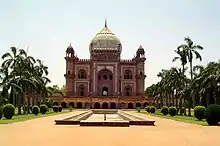Safdar Jang | |
|---|---|
| Mirza Nawab of Oudh Nawab Wazir al-Mamalik Wazir ul-Hindustan Subedar of Kashmir, Agra & Oudh Khan Bahadur Mir Atish Firdaus Aaramgah[lower-alpha 1] | |
 | |
| Reign | 19 March 1739 – 5 October 1754 |
| Predecessor | Saadat Ali Khan I |
| Successor | Shuja-ud-Daula |
| Full name | Abul Mansur Mirza Muhammad Muqim Ali Khan Safdar Jang |
| Born | 1708 |
| Died | 5 October 1754 (aged 45–46) Sultanpur, India |
| Buried | Safdar Jang's Tomb, Safdar Jung road, New Delhi |
| Noble family | Nishapuri Branch of the Kara Koyunlu |
| Spouse(s) | Ummat-ul-Jahra Begum |
| Father | Siyadat Khan (Mirza Jafar Khan Beg) |
| Military career | |
| Allegiance | |
| Service/ | Nawab of Awadh |
| Rank | Subahdar |
| Battles/wars | Mughal-Maratha Wars |
Abul Mansur Mirza Muhammad Muqim Ali Khan Beg (c. 1708 – 5 October 1754), better known as Safdar Jang, was a major figure at the Mughal court during the declining years of the Mughal Empire. He became the second Nawab of Awadh when he succeeded Saadat Ali Khan I (his maternal uncle and father-in-law) in 1739. All future Nawabs of Awadh were patriarchal descendants of Safdar Jang.
Biography
He was a descendant of Qara Yusuf of the Kara Koyunlu. In 1739, he succeeded his father-in-law and maternal uncle, Burhan-ul-Mulk Saadat Ali Khan I to the throne of Oudh and ruled from 19 March 1739 to 5 October 1754. The Mughal Emperor Muhammad Shah gave him the title of "Safdar Jang".[1]
Safdar Jang was an able administrator. He was not only effective in keeping control of Awadh, but also managed to render valuable assistance to the weakened Emperor Muhammad Shah. He was soon given governorship of Kashmir as well, and became a central figure at the Delhi court. During the later years of Muhammad Shah, he gained complete control of administration over the whole Mughal Empire. When Ahmad Shah Bahadur ascended the throne at Delhi in 1748, Safdar Jang became his Wazir-ul-Malik-i-Hindustan or Prime Minister of Hindustan. He was also made the governor of Ajmer and became the "Faujdar" of Narnaul. However, court politics eventually overtook him and he was dismissed in 1753.[1] He returned to Oudh in December 1753 and selected Faizabad as his military headquarters and administrative capital. He died in October 1754 at the age of 46 years in Sultanpur near Faizabad.[1]
Safdar Jang had maintained a contingent of 20,000 "Mughaliya" cavalry, most of whom were Hindustani Muslims, many who were chiefly from the Jadibal district of Srinagar in Kashmir, who had imitated the Qizilbash in dress and spoke the Persian language.[2][3] The state also saw a large migration of Kashmiri Shi'as to the Shi'a kingdom of Awadh, both to escape persecution and to secure courtly patronage.[4] This was especially the case with men from the district of Jadibal in Kashmir, who were all Shias, who looked to Safdar Jang as the sword-arm of the Shi'as in India.
Tomb

Safdar Jang's Tomb was built in 1754 and is situated on a road now known as Safdar Jang Road, in New Delhi.[5]
Several other modern structures near the tomb also carry his name today like Safdar Jang Airport and Safdar Jang Hospital.
See also
Notes
- ↑ Title after death.
References
- 1 2 3 HISTORY OF AWADH (Oudh) a princely State of India by Hameed Akhtar Siddiqui
- ↑ Sarkar, Jadunath (1964). Fall Of The Mughal Empire Vol. 1. digitallibraryindia; JaiGyan. p. 254.
- ↑ Srivastava, Ashirbadi Lal (1933). textsThe First Two Nawabs Of Oudh (a Critical Study Based On Original Sources) Approved For The Degree Of Ph. D. In The University Fo Lucknow In 1932.
- ↑ Hakim Sameer Hamdani (2022). Shi'ism in Kashmir:A History of Sunni-Shia Rivalry and Reconciliation. ISBN 9780755643967.
- ↑ "Safdar Jang Tomb Garden". Archived from the original on 27 September 2007. Retrieved 28 March 2007.
External links
- Indiacoins has an article on Safdarjung here
- Tomb of Safdarjung